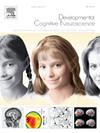Longitudinal analysis of the ABCD® study
IF 4.9
2区 医学
Q1 NEUROSCIENCES
引用次数: 0
Abstract
The Adolescent Brain Cognitive Development® (ABCD) Study provides a unique opportunity to investigate developmental processes in a large, diverse cohort of youths, aged approximately 9–10 at baseline and assessed annually for 10 years. Given the size and complexity of the ABCD Study, researchers analyzing its data will encounter a myriad of methodological and analytical considerations. This review provides an examination of key concepts and techniques related to longitudinal analyses of the ABCD Study data, including: (1) characterization of the factors associated with variation in developmental trajectories; (2) assessment of how level and timing of exposures may impact subsequent development; (3) quantification of how variation in developmental domains may be associated with outcomes, including mediation models and reciprocal relationships. We emphasize the importance of selecting appropriate statistical models to address these research questions. By presenting the advantages and potential challenges of longitudinal analyses in the ABCD Study, this review seeks to equip researchers with foundational knowledge and tools to make informed decisions as they navigate and effectively analyze and interpret the multi-dimensional longitudinal data currently available.
ABCD®研究的纵向分析
青少年大脑认知发展(ABCD)研究提供了一个独特的机会来调查一个大的、不同的青少年队列的发展过程,基线年龄约为9-10岁,每年评估10年。鉴于ABCD研究的规模和复杂性,分析其数据的研究人员将遇到无数的方法和分析方面的考虑。本文综述了与ABCD研究数据纵向分析相关的关键概念和技术,包括:(1)发育轨迹变异相关因素的表征;(2)评估暴露水平和暴露时间对后续发展的影响;(3)量化发育领域的变化如何与结果相关,包括中介模型和相互关系。我们强调选择合适的统计模型来解决这些研究问题的重要性。通过介绍ABCD研究中纵向分析的优势和潜在挑战,本综述旨在为研究人员提供基础知识和工具,以便他们在浏览和有效分析和解释当前可用的多维纵向数据时做出明智的决策。
本文章由计算机程序翻译,如有差异,请以英文原文为准。
求助全文
约1分钟内获得全文
求助全文
来源期刊

Developmental Cognitive Neuroscience
NEUROSCIENCES-
CiteScore
7.60
自引率
10.60%
发文量
124
审稿时长
6-12 weeks
期刊介绍:
The journal publishes theoretical and research papers on cognitive brain development, from infancy through childhood and adolescence and into adulthood. It covers neurocognitive development and neurocognitive processing in both typical and atypical development, including social and affective aspects. Appropriate methodologies for the journal include, but are not limited to, functional neuroimaging (fMRI and MEG), electrophysiology (EEG and ERP), NIRS and transcranial magnetic stimulation, as well as other basic neuroscience approaches using cellular and animal models that directly address cognitive brain development, patient studies, case studies, post-mortem studies and pharmacological studies.
 求助内容:
求助内容: 应助结果提醒方式:
应助结果提醒方式:


